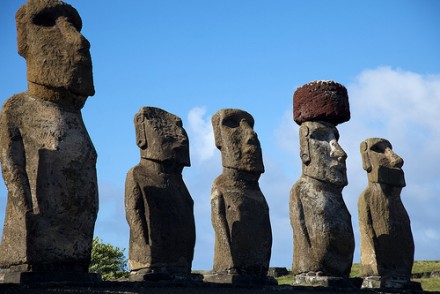 Easter is a small island 2,000 miles off the west coast of South America, 1,250 miles from the nearest inhabitable land of Pitcairn Island. It is famous for its more than 900 gigantic stone heads, weighing up to 200 tons, and for its abandonment by humans.
Easter is a small island 2,000 miles off the west coast of South America, 1,250 miles from the nearest inhabitable land of Pitcairn Island. It is famous for its more than 900 gigantic stone heads, weighing up to 200 tons, and for its abandonment by humans.Why Easter Island was abandoned
Easter was one of the last Polynesian islands to be inhabited. At its peak, the population was only about 7,000, partly controlled by the fact that the only fresh water was from lakes inside extinct volcanoes. Because of its remoteness, the island had only a few indigenous plants and animals for humans' food.
When the first Europeans visited the island in the 18th century, the population had been reduced to only a few hundred people, and it was almost completely treeless. However, analysis of pollen types has shown that at the time of its initial settlement, Easter Island had a dense vegetation cover.
Archaeologists have pieced together the reasons for the society's collapse.
As the population slowly increased, trees were felled to provide clearings for agriculture; fuel for heating and cooking; construction material for household goods and pole-and-thatch houses; and canoes for fishing.
Trees of great girth were required as rollers to move the great statues from distant quarries to ceremonial sites. The need for tree rollers increased as competition between clans to erect statues grew. By 1600, the island was almost completely deforested, and statue-building was halted, leaving many images stranded at the quarry.
After 1500, the shortage of trees had forced many people to live in caves or stone shelters dug into hillsides. Canoes could no longer be built, and only reed boats incapable of long voyages could be made. Fishing was also more difficult because nets had been made from the paper mulberry tree, which was also made into clothing. Removal of the tree cover also badly affected the nutrients for crops. Human life could no longer be sustained.
The collapse of Easter Island's civilization is held up as the premier example of a manmade ecological disaster -- and a lesson to modern humans about the dangers of rampant deforestation.